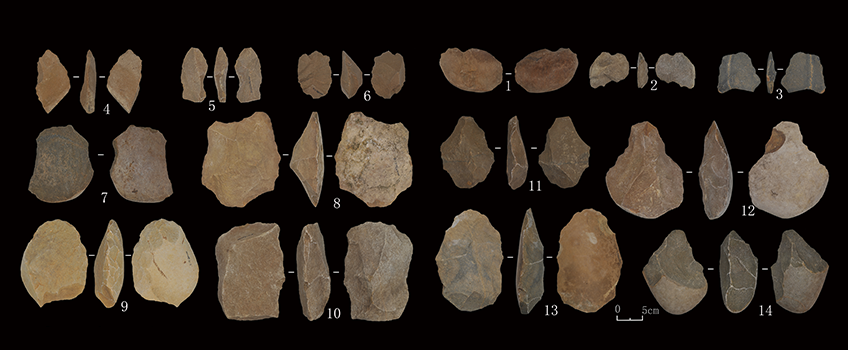

An archaeological investigation of Paleolithic materials in the Fujiang River Basin, Northwest Chongqing
Received date: 2022-12-22
Accepted date: 2023-04-14
Online published: 2023-12-14
The Paleolithic archaeological work in the Fujiang River valley in northwestern Chongqing is almost blank. In the early years, sporadic archaeological surveys and excavations were carried out in Hechuan, with a small number of paleolithic artifacts discovered, making it difficult to fully understand the distribution of paleolithic sites and the technical facets of the lithic industry in this area. On the occasion of the joint archaeological survey of the Fujiang River valley conducted by Sichuan and Chongqing, the Chongqing Cultural Relics and Archaeology Research Institute and School of Culture Heritage of Northwest University collaborated to carry out a special survey of Paleolithic archaeology in the Fujiang River Valley, from March to April 2022. This survey had discovered 46 new Paleolithic sites, densely distributed in the 3-8 terraces on both sides of the main stream of Fujiang River, a total of 833 lithic artifacts were collected. Most of the lithic artifacts came from ground surface, a few were found in the exposed strata.
After preliminary analysis, we can found out that the raw materials of lithic artifacts were mostly taken from the gravel layer nearby, they were made of a single raw material, with quartzite taking the absolute advantage. Also lithic artifacts revealed various knapping methods, large flakes production technology was extremely mature. There were many types of the artifacts, especially the combination of hand axes, picks, and cleavers-like tools and the productions of large flakes technology were featured. The majority of the tools were made by flakes, their working edges appeared to be retouched by one-side direct hammer percussion, the retouched scars mostly was single layer. The overall size of the lithic artifacts was thick and heavy, the large sizes dominated, with medium and huge sizes also making up a significant fraction of the total, the shape and size of lithic artifacts varied greatly. From a technological and typological perspective, at least three different techniques can be observed from these lithic artifacts, including pebble techniques, flake techniques and Acheulean techniques.
According to the terrace context, stratigraphic deposit and assemblages, it is inferred that these sites may span a small range of ages, the time of which should be broadly concentrated in the Middle-Late Pleistocene. The new discoveries in the lower Fujiang River contrast with the previously discovered lithic industry in the Three Gorges region, with differences clearly greater than commonalities, technically related but with more regional specificities. The results of this survey indicate that Fujiang River Valley was also an active area of early human migration, dispersal and survival evolution, with a significant influence on the study of the distribution and transmission routes of Acheulean technology.

Key words: Northwest Chongqing; Fujiang River; Stone artifacts; Handaxe
Cunding HE , Jin ZHANG , Lei GAO , Xinyi HE , Dadi LI . An archaeological investigation of Paleolithic materials in the Fujiang River Basin, Northwest Chongqing[J]. Acta Anthropologica Sinica, 2023 , 42(06) : 815 -826 . DOI: 10.16359/j.1000-3193/AAS.2023.0057
| [1] | 袁钧. 三江流域的石器采集点[A]. 见:重庆市文化局文物处,重庆市博物馆(编).三江考古调查纪要[Z].内部资料 1987, 4-9 |
| [2] | 重庆市文物考古所. 渝南高速公路(重庆段)沿线考古调查勘探报告[J]. 四川文物, 2006, S1: 4-11 |
| [3] | 四川省水利电力厅. 涪江志[M]. 成都: 四川省水利电力厅, 1990, 1: 1-48 |
| [4] | 重庆市合川区志编纂委员会. 重庆市合川区志[M]. 北京: 方志出版社, 2019, 58-70 |
| [5] | 潼南区地方志编纂委员会. 潼南区志[M]. 成都: 四川人民出版社, 1993, 1-49 |
| [6] | 重庆市铜梁区党史地方志研究中心. 2021铜梁年鉴[M]. 重庆: 西南大学出版社, 2021, 70-89 |
| [7] | 李承三, 周廷儒, 郭令智, 等. 嘉陵江流域地理考察报告[J]. 地理专刊, 1946, 1: 68-72 |
| [8] | 高星. 中国旧石器时代手斧的特点与意义[J]. 人类学学报, 2012, 31: 97-112 |
| [9] | Lycett SJ, Norton CJ. A demographic model for Palaeolithic technological evolution: The case of East Asia and the Movius Line[J]. Quaternary International, 2010, 211: 55-65 |
| [10] | 贺存定, 陈少坤, 秦利, 等. 重庆主城周边旧石器考古调查研究[A]. 见:董为(主编).第十三届中国古脊椎动物学学术年会论文集[C]. 北京: 中国海洋出版社, 2012, 165-172 |
| [11] | 裴树文, 卫奇, 冯兴无, 等. 高家镇旧石器遗址1998年出土的石制品[J]. 人类学学报, 2005, 2: 104-120 |
| [12] | 陈福友, 高星, 裴树文, 等. 冉家路口旧石器遗址初步研究[J]. 人类学学报, 2004, 4: 292-306 |
| [13] | 裴树文, 高星, 冯兴无, 等. 井水湾旧石器遗址初步研究[J]. 人类学学报, 2003, 4: 261-278 |
| [14] | 裴树文, 陈福友, 冯兴无, 等. 三峡地区枣子坪旧石器遗址[J]. 人类学学报, 2004, 3: 200-212 |
| [15] | 冯兴无, 裴树文, 陈福友. 烟墩堡遗址研究[J]. 人类学学报, 2003, 3: 177-191 |
| [16] | 李宣民, 张森水. 铜梁旧石器文化之研究[J]. 古脊椎动物与古人类, 1981, 4: 359-371, 386-389 |
/
| 〈 |
|
〉 |